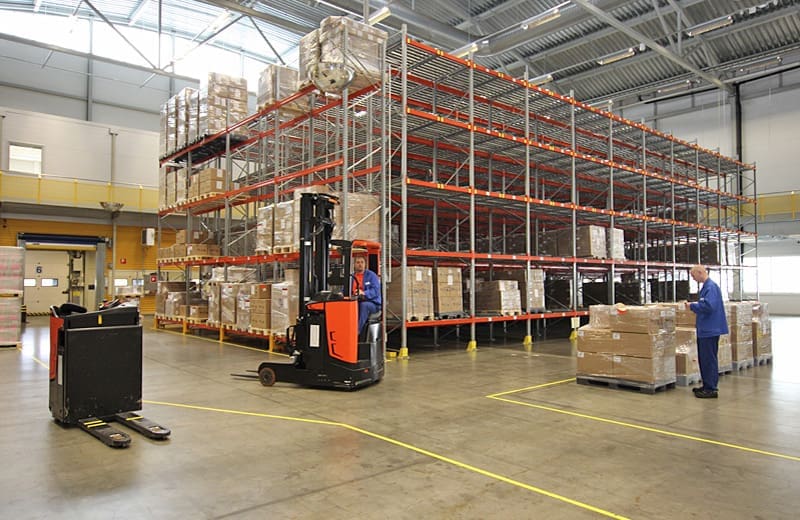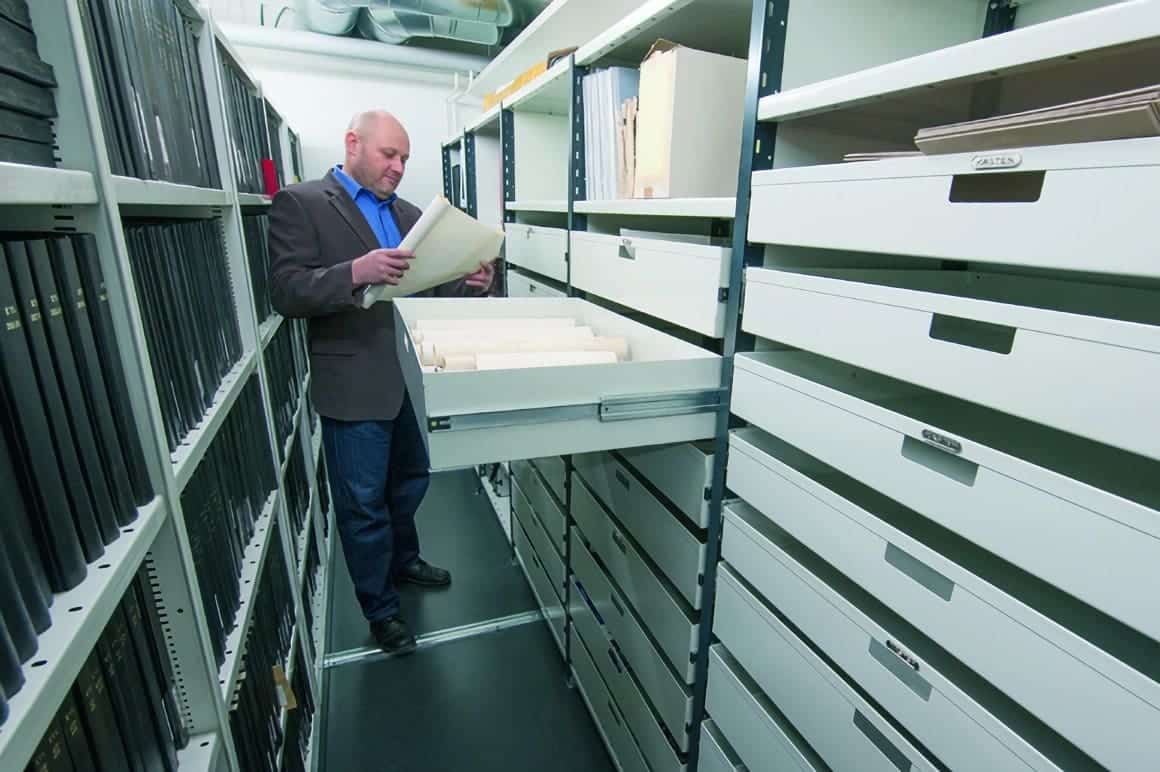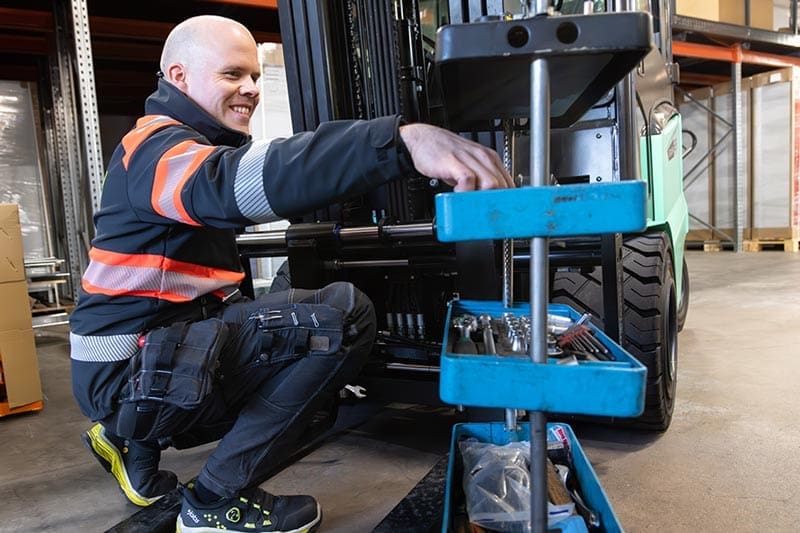An electric forklift is a quiet, zero‑emission and versatile workhorse for materials handling. It suits indoor use and also occasional outdoor tasks. Charging the battery is straightforward, and using an exchangeable battery keeps the truck productive across full shifts without waiting for charging.
Choose a 3‑wheel model when space is tight and turning agility matters. A 4‑wheel electric forklift is the stable choice for heavier loads and longer runs. Typical lifting classes are 1,000–2,000 kg for 3‑wheel models and 1,600–5,000 kg for 4‑wheel models. Heated safety cabins are available for year‑round operation.
With battery power there are no exhaust gases, so indoor air stays fresh. Low running noise improves comfort; because the truck can be very unobtrusive, additional warning lights can enhance safety where needed.

Storage and shop furniture
The furnishing concept of Motonet's headquarters and Finland's largest automotive accessories store is practical and durable.

Shelving, Racking and Forklifts
The forklift, automated storage, and furniture solutions for Orion's pharmaceutical packaging and logistics facility in Salo were customized specifically to meet the customer’s needs.

Archive and storage shelving
The University of Turku Library has been modernized, including its material storage facilities
Electric forklifts – also called battery‑powered forklifts – cover many use cases. The general term “warehouse trucks” is often used for all battery‑powered trucks. In addition to electric models, counterbalance forklifts are also available with LPG or diesel engines. They can also be named by application: pallet‑moving trucks, order‑picking trucks, stackers, reach trucks or narrow‑aisle trucks.
A counterbalance forklift is an excellent tool for loading vehicles and moving goods in yard areas. These trucks also perform well in demanding unloading and loading tasks. 3‑wheel models typically lift 1,000–2,000 kg and offer nimble manoeuvrability in tight spaces; 4‑wheel models typically lift 1,600–5,000 kg and provide greater stability. Electric models are suitable for occasional outdoor use, and a heated safety cabin is available.
Battery‑electric drive does not burden the environment with exhaust emissions and is therefore ideal for indoor areas. The power source is a battery. Batteries are charged regularly, or in multi‑shift use a battery exchange system is used so there is no downtime for charging. Because there are no harmful exhaust gases, indoor air remains fresh.
The truck runs quietly and does not add unnecessary noise to the workplace. In fact, it can be so unobtrusive that warning lights are advisable to increase safety. A quiet truck and a calm working environment are more pleasant for the driver and for everyone nearby.
Compared with LPG or diesel forklifts, battery‑powered forklifts are significantly quieter and cleaner. They require less maintenance and often achieve a longer service life.
Excellent for indoor spaces and occasional outdoor work
Choose a 3‑wheel electric forklift for tight areas; a 4‑wheel model adds stability
1,000–5,000 kg suits many applications
Heated safety cabins for year‑round use
There are many types on the market today. Typical examples include:
You will find a good selection of trucks with us to help you get your work done quickly and efficiently.
The advantages of modern electric forklifts compared with combustion‑engine trucks are similar to the differences between electric cars and combustion cars. In outdoor work, pre‑heating and intermittent operating times do not stress the truck in the same way as cold starts affect combustion engines. Traction is usually better, depending on whether the manufacturer has implemented drive with direct‑drive motors (two traction motors). Ask us about Finland‑made electric forklifts designed for Nordic conditions!
Contact: myynti@thtt.fi
It is a modern, environmentally friendly and high‑performance choice for many load‑handling tasks. Whether it is daily pallet transfers in a warehouse or loading heavy goods in yard areas, the trucks handle the work with ease. Charging is convenient by swapping a battery or at a charging point, so efficiency stays high even when the truck is used intensively throughout a shift. Low operating noise improves comfort, and zero emissions make this an excellent option for both indoor areas and outdoor tasks.
These trucks come in several models. A 3‑wheel model is a nimble choice for tight spaces such as aisles and containers where a small turning radius is essential. Its typical lift range is 1,000–2,000 kg. A 4‑wheel model offers stability and suits situations where higher capacity (1,600–5,000 kg) or longer operating times are required. A heated cabin enables year‑round use in varying weather conditions.
The range includes different battery‑powered truck types for pallet moving, order picking and stacking. A properly dimensioned warehouse truck eases work and reduces unnecessary moves, keeping daily logistics efficient.
Warehouse trucks and indoor counterbalance forklifts are powered by batteries. Battery voltage ranges from 12 to 80 volts. When choosing a battery, consider that one charge should last at least a full shift. Keeping batteries in good condition is the most important maintenance task for electric forklifts. Ideally, discharge to about 20% state of charge and then recharge fully; this helps service life. Attention must also be paid to choosing a battery charger that suits the battery and the truck’s operating pattern. Charging time typically ranges from 6 to 14 hours. Safety must also be ensured during charging: the charging area needs sufficient ventilation so that the potentially explosive hydrogen gas produced during charging is removed from the space. After charging, check that the electrolyte (battery water) level is at the correct height.
Ideal usage is not always possible, but if two batteries are reserved for one truck, you can discharge to about 20% and then charge fully. Changing a battery takes only a few minutes. Ask for more information about battery exchange systems.
Contact: myynti@thtt.fi
Ensure uninterrupted work with a spare battery. When batteries can be exchanged, work can be planned more efficiently without fear of the battery running out mid‑shift. An additional battery ensures longer operating time. Planning and execution improve when a fully charged battery is always available. This reduces waiting and makes it possible to complete work as planned. A spare battery is a practical accessory that increases efficiency and ensures the truck is always ready when needed.
Punnitseva haarukkavaunu Rocla RHW‑22 Dual spare battery provides extra power for the scale pallet truck and ensures continuous availability even in demanding environments. This high‑quality spare battery is designed to complement the RHW scale pallet truck, helping users operate for longer periods without interruption and increasing productivity and efficiency.
Additional battery for the EP F4 1500 kg electric pallet truck is a Li‑ion 24 V / 20 Ah type, which provides about 3.5 hours of operating time on one charge. Charging to full takes about 2.5 hours.
The most common electric forklift battery type is still the lead‑acid battery. Lead‑acid requires more maintenance and regular charging to remain durable. The battery must be watered, and charging should be regular. A lead‑acid battery works well when usage is regular and charging is taken care of. It is clearly the most affordable option.
Different lithium battery technologies suit electric forklifts well, and their service life is not reduced by partial charging cycles or irregular use in the same way as with lead‑acid. A lithium‑ion battery is particularly suitable for a truck used infrequently, and its size can be specified smaller than a comparable lead‑acid battery. A lithium battery can usually be charged at a much higher current than lead‑acid, minimising downtime in intensive use.
Battery life depends on the model and level of use. For longer shifts, arrange battery exchange or fast‑charging points. For example, a Li‑ion 24 V / 20 Ah battery type provides about 3.5 hours of use on one charge. Charging to full takes about 2.5 hours.
Yes. Most models can be specified with a heated safety cabin, and the right tyre choice ensures operation during the winter season.
Basic maintenance includes checking the battery and hydraulics plus regular mechanical service. Always follow the manufacturer’s service instructions.
Yes, but always follow the manufacturer’s recommendations and accessories if the truck is used in harsher environments.

Whatever your needs, we’re always happy to help. Our knowledgeable sales team is here for you—together we’ll figure out how to make your warehouse more functional, safer, and efficient. We can even join you early on, right from the planning stage if you’d like.
Tuijussuontie 6
21280 Raisio, FINLAND
View on map »